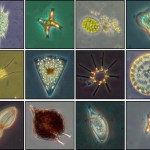Cat
Today for Monday Pets, we're going to go old school and talk about vision.
Vision is arguably our most (intentionally) utilized sensory system, so its pretty important to figure out how it works. And it's what David Hubel and Torsten Wiesel set out to investigate starting in the late 1950s. Ultimately, their work would get them a Nobel Prize in Physiology or Medicine, in 1981.
Basically, they took a bunch of cats, anesthetized them, and showed them patterns of light on a screen. Meanwhile, some microelectrodes were placed in various precisely determined spots in the cat's visual cortex, and…
A margay (Leopardus wiedii). From Wikipedia.
Even if they spend years in the field, researchers rarely witness predation on primates. Cats, birds, and other hunters regularly feed on primate species, but what we know about the habits of primate-hunters often comes from bones and fingernails picked out of predator droppings. Every now and again, though, someone is in just the right place at just the right time to observe a predator attempt to catch a primate for dinner, and one recent observation in the Amazon has revealed an ingenious hunting technique employed by a small spotted cat.…
A partially dissected head of an ocelot (Leopardus pardalis), showing some of the internal anatomy, in the collection at the New Jersey State Museum. (And here is a similar preserved sea lion head in the same collection.)
Charlotte yawns before washing herself, although, on the other hand, she does look like she could be laughing. Lol.
A jaguar (Panthera onca). From Flickr user Prosper 973.
One year ago this week Macho B was euthanized. He had been captured in mid-February of 2009, the only known jaguar living inside the United States, but after he was caught and fitted with a radio collar his health quickly deteriorated. When he nearly stopped moving he was recaptured, taken to the Phoenix zoo, and put to sleep when it was discovered that he was suffering from irreparable kidney failure.
At first it seemed as if his capture was a lucky accident, but a later investigation by the Fish and Wildlife Service found that the…
A reconstruction of Smilodon, photographed at the American Museum of Natural History.
When it comes to animals, encyclopedias often present us with generalized descriptions. Where a creature lives, what color it is, what it eats, and other tidbits of information are listed to distinguish one species from another, but what is lost is an appreciation of variation. Be they genetic, anatomical, or behavioral, variations are grist for natural selection's mill, and if you study any species in detail it becomes apparent that individuals differ considerably over space and through time.
This was…
Although the paper addresses Tanzanian lions, this is a photograph of a Namibian lion Starting some years ago, we began to hear about revisions of the standard models of lion behavioral biology coming out of Craig Packer's research in the Serengeti. One of the most startling findings, first shown (if memory serves) as part of a dynamic optimization model and subsequently backed up with a lot of additional information, is the idea that lions do not benefit by living in a group with respect to hunting. They live in groups despite the fact that this sociality decreases hunting…
While I was out of town this weekend, one of my friends lost her dog. As I read over the many caring comments on her Facebook page, it struck me how difficult it is to express condolences - especially on the loss of a pet. Like many others, I ended up simply saying "I'm sorry."
The significance of the relationship between pet and person is often minimized, even though we know that the unconditional love supplied by a pet can do astonishing things for human mental and physical health. Personally, I don't believe animals have souls, but neither do I believe they are soulless automatons. Cats…
Katz:
Dawg:
OK, so the Dawg obvoiusly wins. Let's give the katz one more chance:
Winged kitty cats are not unheard of in China, but a new alate feline is always news.
The winged cats can not fly, of course, or you would have heard about them before. They would be like these flying killer sharks.
Scientists have narrowed down the explanation for the growth of these wings as environmental, or genetic, or developmental.
...scientists believe the appendages developed due to grooming habits, a genetic defect or a hereditary skin condition.
.... keep us posted on that, scientists.
Source is MSNBC, hat tip to Rebecca Skloot.
Scientific American has a long piece reviewing the recent genetic insights into the origins and development of the most awesome pets of all:
It is by turns aloof and affectionate, serene and savage, endearing and exasperating. Despite its mercurial nature, however, the house cat is the most popular pet in the world. A third of American households have feline members, and more than 600 million cats live among humans worldwide. Yet as familiar as these creatures are, a complete understanding of their origins has proved elusive. Whereas other once wild animals were domesticated for their milk,…
If you wanted to turn a rat into a fearless critter, unfazed by cats or bigger rats, the best way would be to neutralise a small pair of tiny structures in its brain called the dorsal premammillary nuclei, orPMD. According to new research by Simone Motta at the University of Sao Paolo, these small regions, nestled within a rat's hypothalamus, control its defensive instincts to both predators and other rats.
But not all neurons in the PMD are equal. It turns out that the structures are partitioned so that different bits respond to different threats. The front and side parts (the ventrolateral…
Has, sadly, died.
It was just a month ago that ScientificAmerican.com reported the happy tale of a lost cat named George that came home 13 years after rescuers traced his owners through information on a microchip in the scruff of his neck.
He was nearly 17, sick and rail-thin, less than half the robust nearly 14 pounds (6.4 kilograms) he was when he mysteriously disappeared in June 1995. But Frank Walburg and Melinda Merman of Santa Rosa, Calif., were happy to have him home, and set about trying to bulk up their long-lost kitty and restore his health.
They spent weeks pampering and…
This tiger was owned by a large cat breeder and handler who provides tigers, lions, and some other beasts for the entertainment industry. Notice the white spots on the tiger's ears. I spent a fair amount of time with this tiger, in its enclosure, photographing it as various other things were going on. As I was the stranger in the room, and since I kept moving, the tiger kept a close eye on me, but not with its actual eyes. I took about a hundred photographs of this animal, and in every single one there are two white spots ... those spots on the ears ... looking at me.
It is said that the…
Lions are more diverse than many may think. Indeed, recent research shows that lions may be comfortably divided into races. An expert on lions can tell you what part of Africa a particular lion is likely from by how it looks. Have a look at these lions:
Anyone who knows anything about lions knows that these are Tarangire lions. Tarangire is a park in Tanzania that I think is somewhat underrated. It could easily be the first choice among parks to visit in Tanzania, rather than the second or third. It has its own migratory system (you can also tell the wildebeest of Tarangire from those…
Cute baby lion kittens. When they grow up, they will want to eat you. I'll never forget the first wild lion I ever saw. It was a pitch black night, on the savanna in the Western Rift Valley. I had climbed on top of the hood of the Land Rover, engine off, but headlights on. My plan was to search the horizon for lights indicating the presence of the research camp I was trying to find. Once I was on the hood, I was about to tell my colleague, still in the vehicle, to cut the headlights so I could see better. That's when she walked into view.
She was a fully adult lioness. Eventually…
Sabertooth Cat, Megantereon nihowanensisl There are two kinds of "true cats." Cat experts call one type feline or "modern" partly because they are the ones that did not go extinct. If you have a pet cat, it's a modern/feine cat. This also includes the lions, tigers, leopards, etc. The other kind are called "sabercats" because this group includes the saber tooth. It is generally believed but not at all certain that these two groups of cats are different phylogenetic lineages (but that is an oversimplification).
It has been suggested for some time that the bite force mechanics for at…
By African standards, Kenya's Amboseli itself is small, but it is part of two or more large scale systems that extend far beyond its boundaries. One is the Serengeti Ecosystem, which extends far to the south in Tanzania. The other is the Nilotic (mainly Maasai) Pastoralist cattle keeping culture. It is being reported that lions in Amboseli are in crisis because of conflict between these two systems.
From a National Geographic Society press release:
Lion populations in and around Kenya's Amboseli National Park have dropped so low due to spearing and poisoning by local Maasai that…

